Abstract
To determine reference values for ectopic activity 147 actively employed healthy men aged from 15 to 65 years were examined by 24 hour Holter monitoring during their ordinary daily activities. Age was the only risk factor significantly associated with supraventricular and ventricular extrasystoles. During a six year follow up only two men died. In both the frequency of ventricular extrasystoles had been high, but neither of them died from cardiovascular disease. Because the distribution of the frequency of extrasystoles in the study group was highly skewed a percentile distribution was used to determine normal values. This distribution showed that 95% of men aged 15-39 years had less than 2.9 ventricular extrasystoles per hour and the same proportion of men aged 40 years or older had less than 36 ventricular extrasystoles per hour. For field studies values above the 90th percentile (that is more than 10 ventricular extrasystoles per hour for men 40 years or older) may be a more appropriate cut off point.
Full text
PDF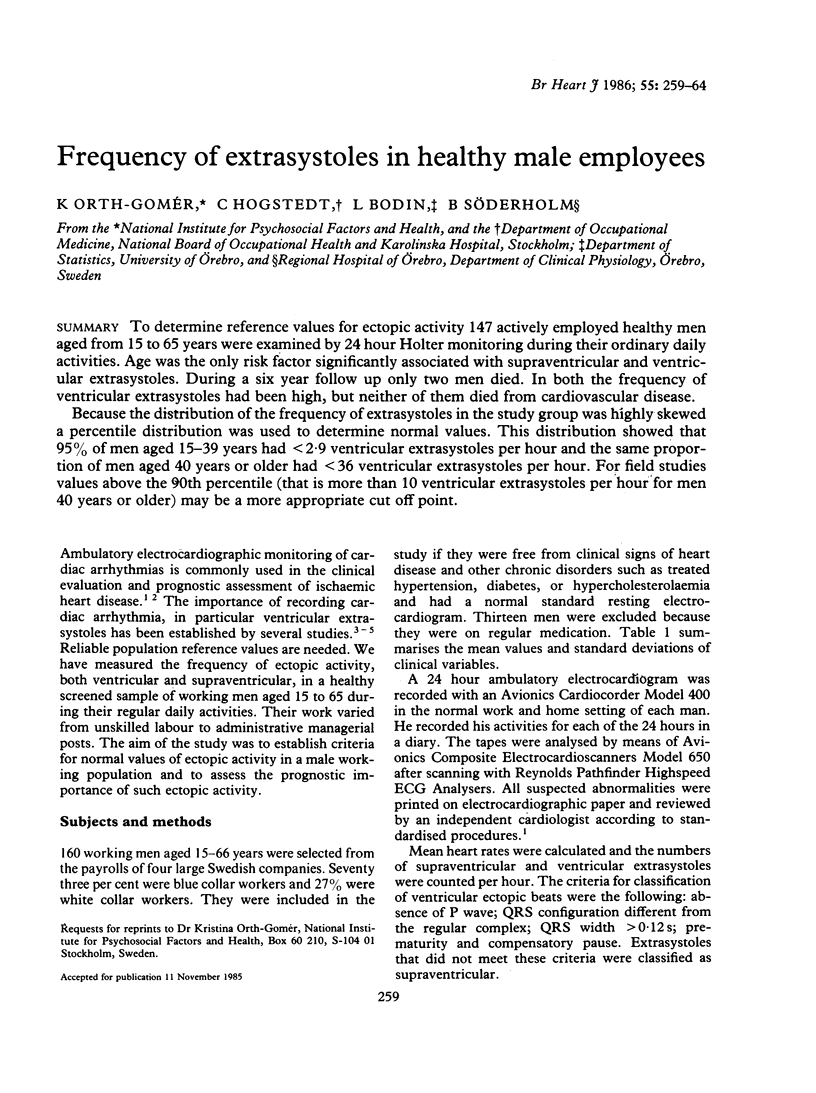
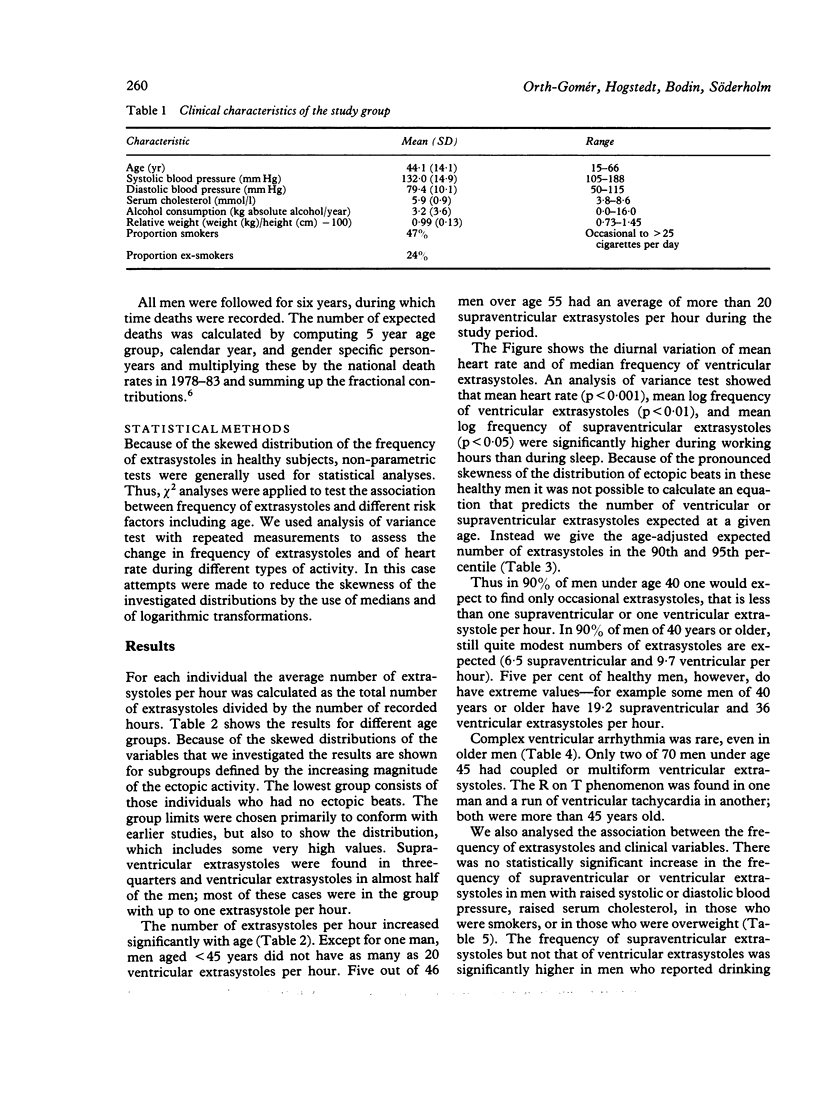
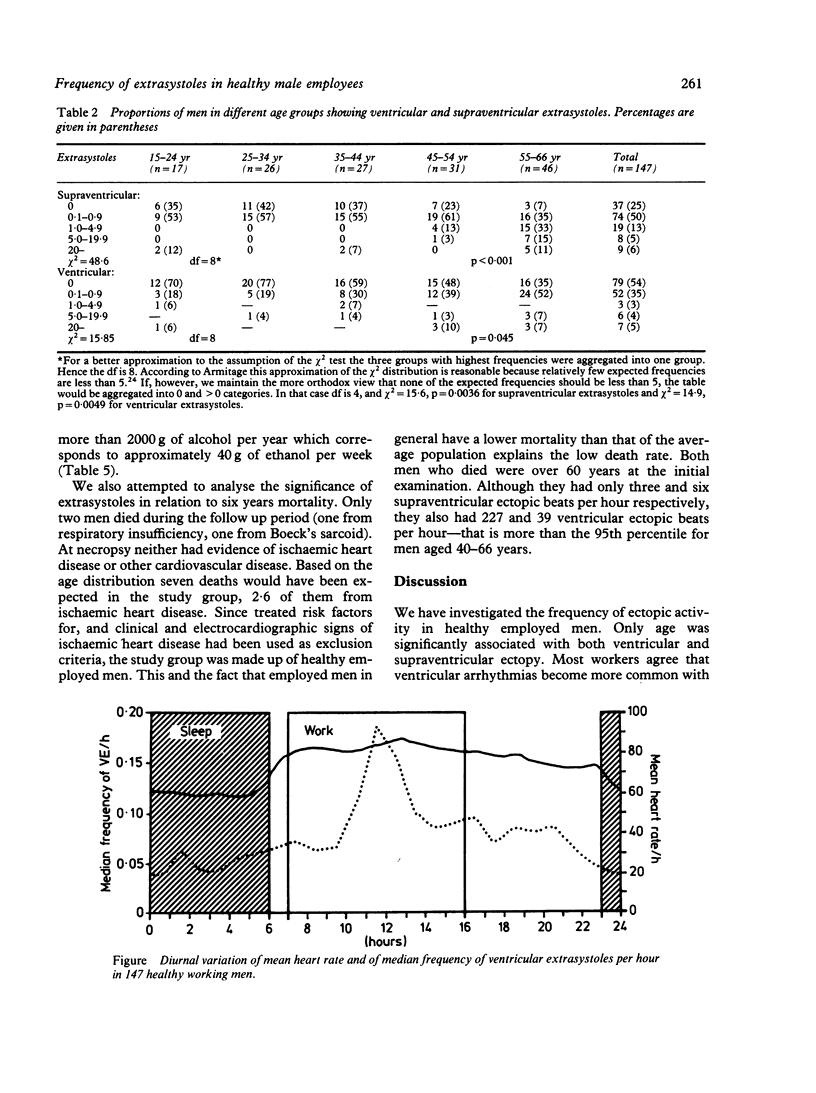
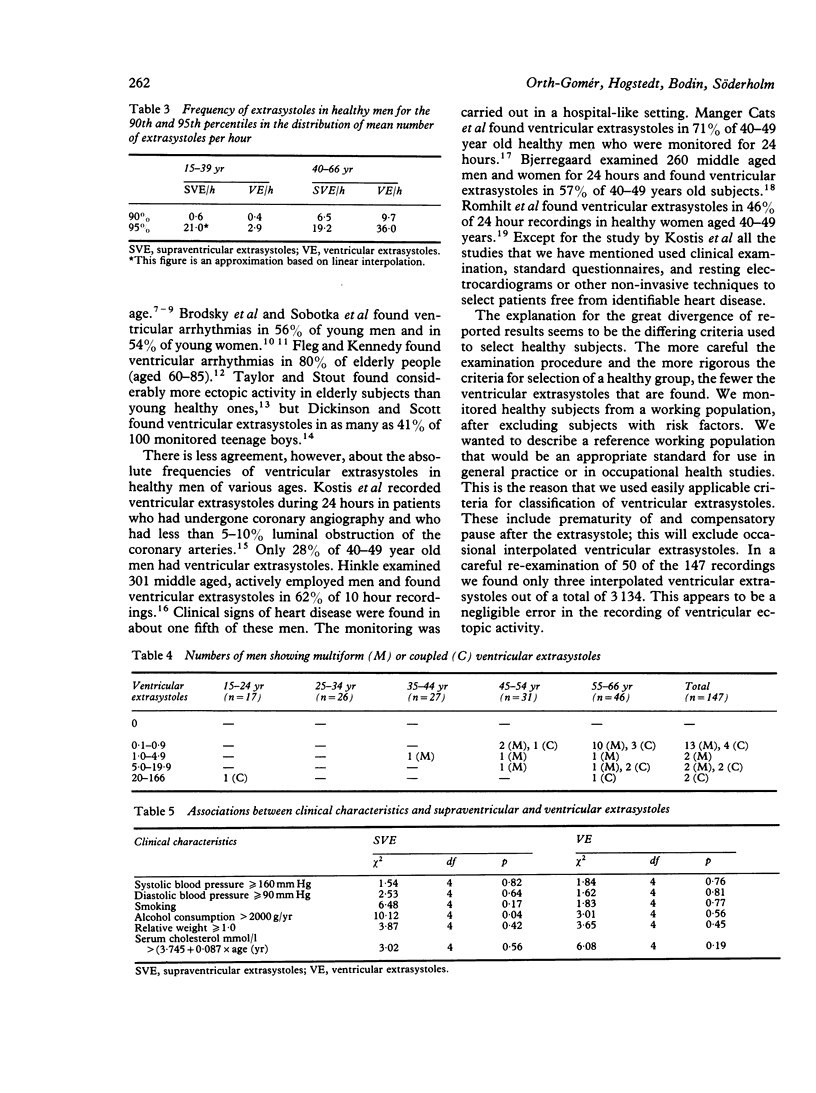
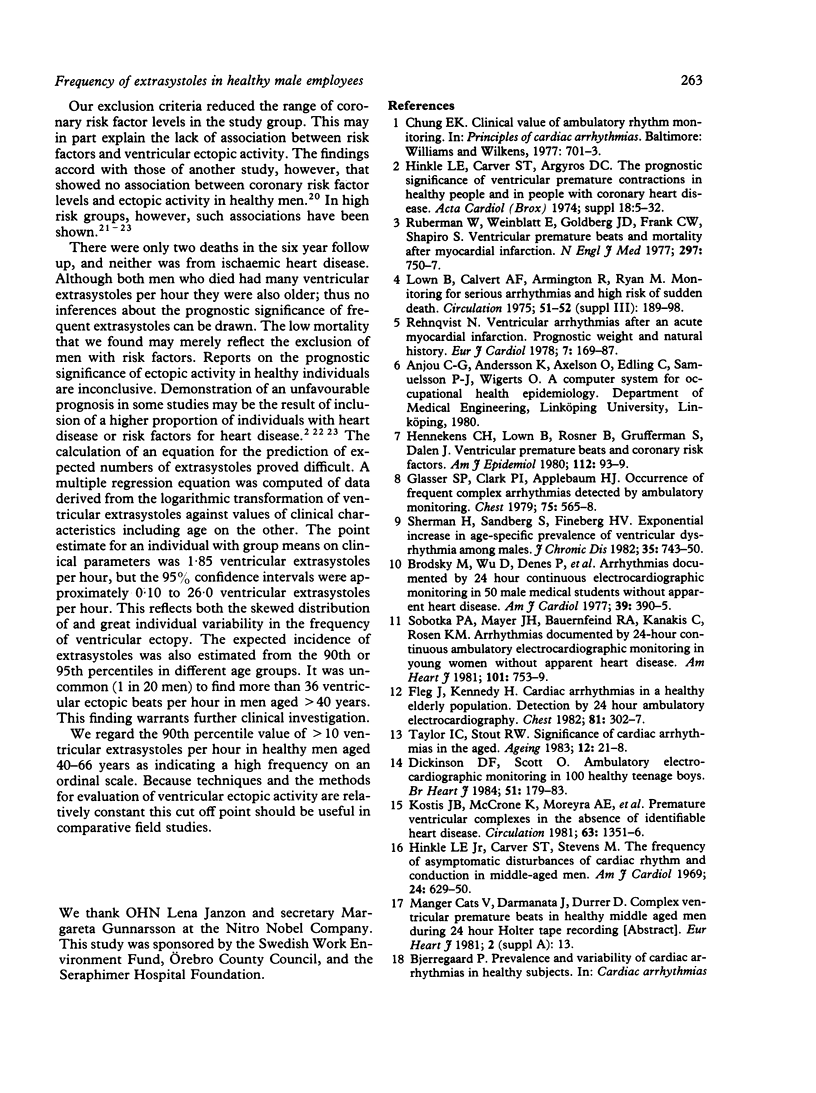

Selected References
These references are in PubMed. This may not be the complete list of references from this article.
- Brodsky M., Wu D., Denes P., Kanakis C., Rosen K. M. Arrhythmias documented by 24 hour continuous electrocardiographic monitoring in 50 male medical students without apparent heart disease. Am J Cardiol. 1977 Mar;39(3):390–395. doi: 10.1016/s0002-9149(77)80094-5. [DOI] [PubMed] [Google Scholar]
- Clarke J. M., Hamer J., Shelton J. R., Taylor S., Venning G. R. The rhythm of the normal human heart. Lancet. 1976 Sep 4;1(7984):508–512. doi: 10.1016/s0140-6736(76)90801-1. [DOI] [PubMed] [Google Scholar]
- Dickinson D. F., Scott O. Ambulatory electrocardiographic monitoring in 100 healthy teenage boys. Br Heart J. 1984 Feb;51(2):179–183. doi: 10.1136/hrt.51.2.179. [DOI] [PMC free article] [PubMed] [Google Scholar]
- Fleg J. L., Kennedy H. L. Cardiac arrhythmias in a healthy elderly population: detection by 24-hour ambulatory electrocardiography. Chest. 1982 Mar;81(3):302–307. doi: 10.1378/chest.81.3.302. [DOI] [PubMed] [Google Scholar]
- Glasser S. P., Clark P. I., Applebaum H. J. Occurrence of frequent complex arrhythmias detected by ambulatory monitoring: findings in an apparently healthy asymptomatic elderly population. Chest. 1979 May;75(5):565–568. doi: 10.1378/chest.75.5.565. [DOI] [PubMed] [Google Scholar]
- Hennekens C. H., Lown B., Rosner B., Grufferman S., Dalen J. Ventricular premature beats and coronary risk factors. Am J Epidemiol. 1980 Jul;112(1):93–99. doi: 10.1093/oxfordjournals.aje.a112980. [DOI] [PubMed] [Google Scholar]
- Hinkle L. E., Carver S. T., Argyros D. C. The prognostic significance of ventricular premature contractions in healthy people and in people with coronary heart disease. Acta Cardiol. 1974;Suppl 18:5–32. [PubMed] [Google Scholar]
- Hinkle L. E., Jr, Carver S. T., Stevens M. The frequency of asymptomatic disturbances of cardiac rhythm and conduction in middle-aged men. Am J Cardiol. 1969 Nov;24(5):629–650. doi: 10.1016/0002-9149(69)90451-2. [DOI] [PubMed] [Google Scholar]
- Kolev N., Cserhalmi L., Palik I., Lengyel M., Romoda T. The use of the first derivative of apex cardiogram and echocardiographic dimensions for assessing left ventricular relaxation and mean velocity of circumferential fibre lengthening in cardiomyopathy. Eur Heart J. 1981 Feb;2(1):13–19. doi: 10.1093/oxfordjournals.eurheartj.a061159. [DOI] [PubMed] [Google Scholar]
- Kostis J. B., McCrone K., Moreyra A. E., Gotzoyannis S., Aglitz N. M., Natarajan N., Kuo P. T. Premature ventricular complexes in the absence of identifiable heart disease. Circulation. 1981 Jun;63(6):1351–1356. doi: 10.1161/01.cir.63.6.1351. [DOI] [PubMed] [Google Scholar]
- Orth-Gomér K. Ventricular arrhythmias and risk indicators of ischemic heart disease. Acta Med Scand. 1980;207(4):283–289. doi: 10.1111/j.0954-6820.1980.tb09722.x. [DOI] [PubMed] [Google Scholar]
- Rehnqvist N. Ventricular arrhythmias after an acute myocardial infarction. Prognostic weight and natural history. Eur J Cardiol. 1978 Apr-May;7(2-3):169–187. [PubMed] [Google Scholar]
- Romhilt D. W., Chaffin C., Choi S. C., Irby E. C. Arrhythmias on ambulatory electrocardiographic monitoring in women without apparent heart disease. Am J Cardiol. 1984 Sep 1;54(6):582–586. doi: 10.1016/0002-9149(84)90253-4. [DOI] [PubMed] [Google Scholar]
- Ruberman W., Weinblatt E., Goldberg J. D., Frank C. W., Shapiro S. Ventricular premature beats and mortality after myocardial infarction. N Engl J Med. 1977 Oct 6;297(14):750–757. doi: 10.1056/NEJM197710062971404. [DOI] [PubMed] [Google Scholar]
- Sherman H., Sandberg S., Fineberg H. V. Exponential increase in age-specific prevalence of ventricular dysrhythmia among males. J Chronic Dis. 1982;35(9):743–750. doi: 10.1016/0021-9681(82)90098-4. [DOI] [PubMed] [Google Scholar]
- Sobotka P. A., Mayer J. H., Bauernfeind R. A., Kanakis C., Jr, Rosen K. M. Arrhythmias documented by 24-hour continuous ambulatory electrocardiographic monitoring in young women without apparent heart disease. Am Heart J. 1981 Jun;101(6):753–759. doi: 10.1016/0002-8703(81)90611-6. [DOI] [PubMed] [Google Scholar]
- Taylor I. C., Stout R. W. The significance of cardiac arrhythmias in the aged. Age Ageing. 1983 Feb;12(1):21–28. doi: 10.1093/ageing/12.1.21. [DOI] [PubMed] [Google Scholar]
- Vedin J. A., Wilhelmsson C. E., Wilhelmsen L., Bjure J., Ekstrom-Jodal B. Relation of resting and exercise-induced ectopic beats to other ischemic manifestations and to coronary risk factors. Men born in 1913. Am J Cardiol. 1972 Jul 11;30(1):25–31. doi: 10.1016/0002-9149(72)90120-8. [DOI] [PubMed] [Google Scholar]


